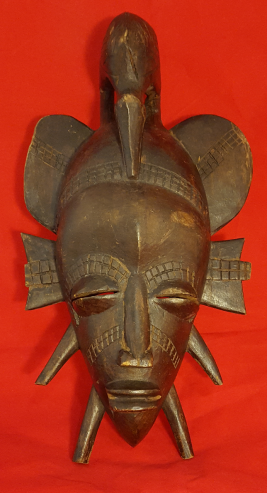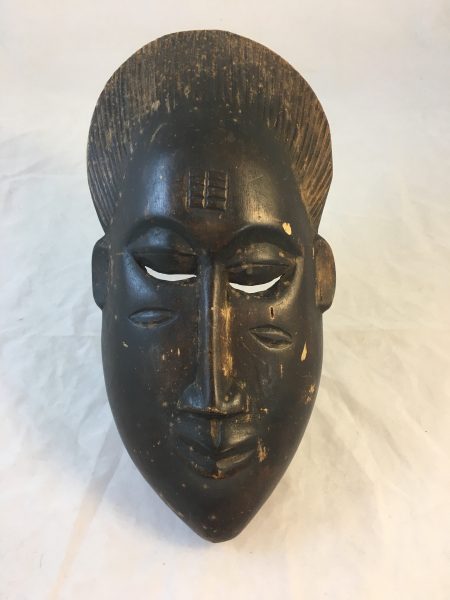
Baule culture
20th century
Wood and pigment, L. 14.8 cm x W. 6.2 cm x H. 29.5 cm
Stoneman collection #1985.10
Portrait masks are made by woodcarvers of the Baule culture to represent a specific woman from the area who is considered important among the villagers. Although they are made in the image of a specific woman, their faces are often idealized and somewhat generalized. They always emphasize the woman’s physical beauty, usually by giving the mask heavy, lidded eyes that gaze downward and idealized, youthful skin. The specific, elaborate hairstyle and the unique patterns of scarification on each mask help viewers to recognize clearly which woman it represents, regardless of the idealization of her features. During a ceremony intending to honor a specific woman, the male performer who wears the mask will purposefully dance and move in a way that mimics the motions of a beautiful woman. The woman being represented by the mask also attends the masquerade and dances alongside the performer.
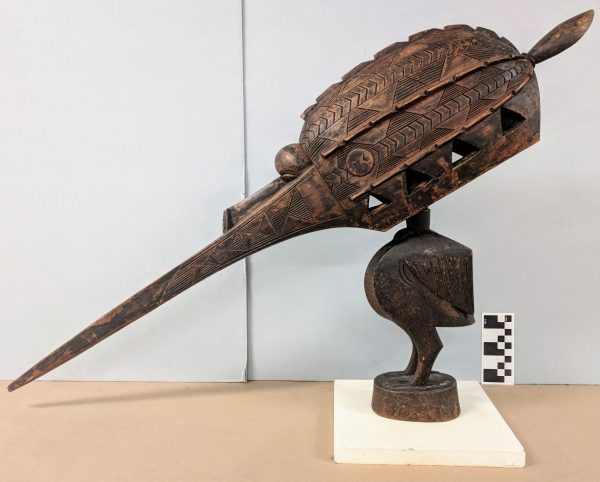
Baga culture
20th century
Wood, L. 86.6 cm x W. 7.3 cm x H. 42 cm
Stoneman collection #1985.35
This headdress is an example of a figure called an a-tshol (plural tshol), made by the Baga people. The figure depicts a composite bird-human spirit with a long protruding bird beak and a small, abstract human face on top of the beak. These headdresses are often housed in a shrine, where they reside among other powerful sculptures whose job is to protect and offer special healing powers to those who own and use them. Tshol primarily serve to protect their patrons from evil spirits, although they can also be used in burial ceremonies or worn as headdresses in masquerades celebrating the harvesting season. It is often stated that the Baga male secret society of Simo owns these figures. This is not always the case, however, as it is oftentimes owned by an entire town or a specific family, and a designated respected elder is put in charge of using it and activating its powers.
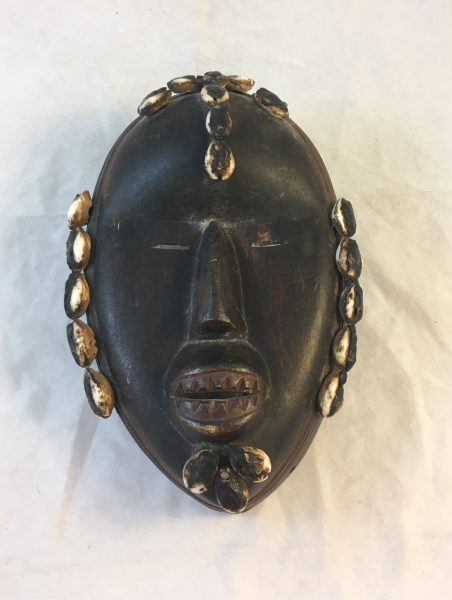
Dan culture
20th century
Wood, pigment, nails, wax and cowrie shells, L. 15 cm x W. 5.6 cm x H. 22.6 cm
Stoneman collection #1985.9
The Dan create feminine masks, which have curvier forms and softer features, as well as masculine masks, which are larger in size and have crude, geometric features that are meant to be frightening. The feminine masks, however, are more common and more numerous. The deangle mask is one of the best-known feminine masks, and it represents benevolent female spirits. The male maskers wear a full costume of cotton cloth and raffia with the mask, and they work hard to take on a feminine persona. The deangle performer’s job is to move in a gentle, feminine way, to interact joyfully with the audience, and to gather up food to bring as gifts to the young boys who have been sent to the initiation and circumcision camps. A carved line down the forehead is a typical feature of these masks, but on this deangle mask, a line of cowrie shells is secured onto the forehead to form a vertical line.
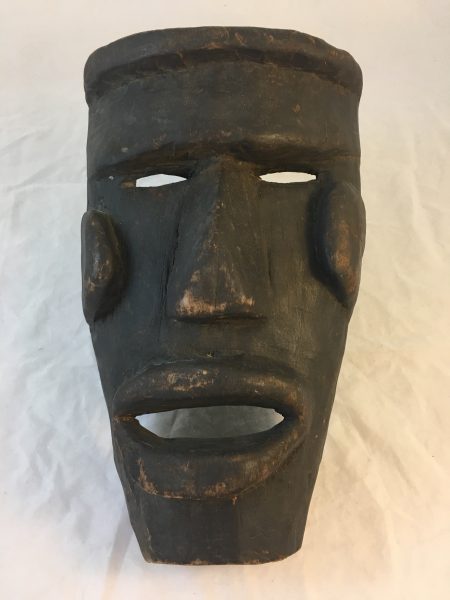
Dan culture
20th century
Wood and pigment, L. 18.4 cm x W. 10.8 cm x H. 30.4 cm
BFPC collection #2016.10
Many masquerades among the Dan intentionally depict spirits that show behavior and actions that are not acceptable in their culture. This mask, with its exaggerated features, is a male mask made to represent a spirit called kagle, who is seen as a troublemaker and who acts in inappropriate and vulgar ways in public. The word kagle means “hooked stick,” as the dancers carry hooked sticks with them – which they sometimes even use to hit onlookers.
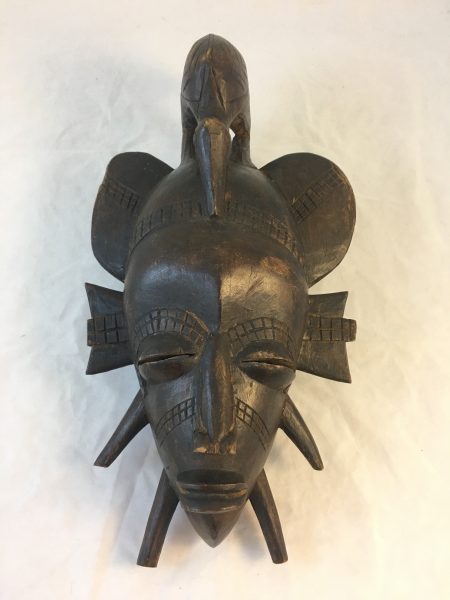
Senufo culture
20th century
Wood and pigment, L. 18.1 cm x W. 9.2 cm x H. 36.1 cm
Stoneman collection #1985.13b
The Senufo are a matrilineal culture, and their woodcarvers make many masks that emphasize the power and significance of women in society. Beautiful Lady masks are one type of feminine mask; these are often referred to in writings generically as kpelie masks, but there are actually many different types of these masks. In Senufo communities, the Poro male secret society is in charge of hosting and performing the ceremonies that use Beautiful Lady and other feminine masks. The men who dance these masks mimic the sensual movements of a beautiful woman, and the masquerades themselves tend to emphasize themes of the importance of the female gender in Senufo society—the physical beauty of women, their fertility and grace, and their supernatural ability to heal others and to protect against malevolent spirits.
Physically, the Beautiful Lady mask tends to have a long, tapering face, with protrusions from the top, side, and bottom that depict elements of an elaborate hairstyle. Many masks also depict scarification patterns on the face, which indicate full adulthood. A polished, dark finish on these masks is indicative of healthy black skin, a feature the Senufo consider an especially beautiful trait in women.
For more information, you may contact the researcher(s) noted in the title of this exhibit entry, or Dr. Billie Follensbee, the professor of the course, at BillieFollensbee@MissouriState.edu

